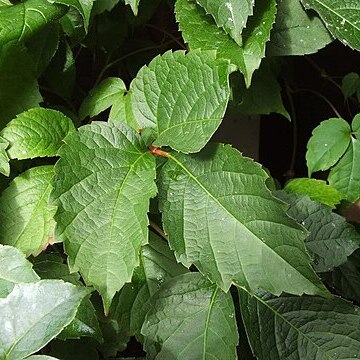Branchlets terete, sparsely pilose when young, becoming nearly glabrescent; tendrils with 4-6 branches, young apex of tendril curving and slender. Leaves 3-foliolate; petiole 3.5-15 cm, sparsely pubescent; leaflets usually nearly sessile, abaxially pubescent on veins, lateral veins 4-7 pairs, veinlets inconspicuous or slightly raised; central leaflet obovate-elliptic or obovate, 5-13 × 3-6.5 cm, base cuneate, margin 6-11-toothed, apex cuspidate; lateral leaflets ovate-elliptic or oblong, 5-10 × 3-5 cm, base asymmetric, nearly rounded, margin toward outside 7-15-toothed, margin toward inside 4-6-toothed, apex mucronate. Polychasium with inconspicuous main axis; peduncles 1.5-3.5 cm, glabrous or slightly pilose. Pedicel 2-3 mm, glabrous. Buds elliptic, 2-3 mm, apex rounded. Calyx entire. Petals ovate-elliptic, 1.8-2 × ca. 8 mm, glabrous. Filaments 0.6-0.9 mm; anthers ovoid-elliptic, 0.4-0.6 mm. Disk inconspicuous. Ovary nearly spherical; style short; stigma not expanded. Berry 6-8 mm in diam., 1-or 2-seeded. Seeds obovoid, base rostrate, apex rounded. Fl. May-Jul, fr. Aug-Oct.
More
A climbing shrub. It has tuberous roots. The vine loses its leaves during the year. It has tendrils that are divided. It climbs 5-8 m high. The leaves have stalks 9 cm long. The leaves have 3 leaflets divided like fingers on a hand. There are teeth around the edge. The leaflets are about 8 cm long by 5 cm wide but the end leaflet is slightly longer and more narrow. The flowers are green and contain both sexes. There can be 100-200 flowers in a cluster. The fruit are round and black. The fruit have 2-4 seeds. The seeds are 4-5 mm long by 2-3 mm wide.
It is a tropical plant. It grows in forests between 500-1,500 m above sea level. In the Indian Himalayas it grows between 2,000-2,800 m above sea level. In Sichuan and Yunnan.
More
Climbing over rocks, 1,200-3,300 metres in W. China. Moist open places at elevations of 2,100-3,200 metres in Nepal.
Can be grown by cuttings or seedlings. Seeds needs soaking.

